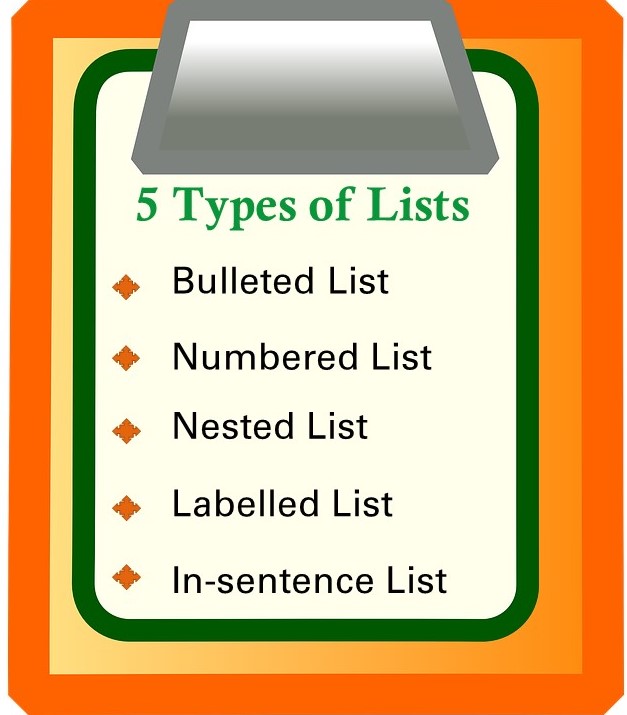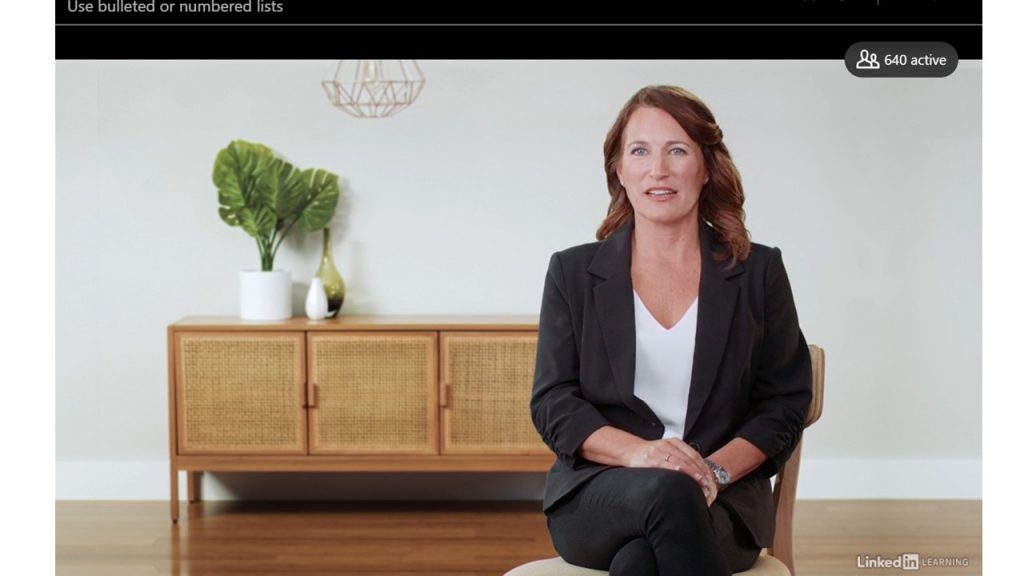3.3 Lists
Open the following link to watch the video Use Bulleted or Numbered Lists
Lists are created when items in a series are dropped into bulleted or itemized points. Lists, when used correctly, can be a technical writer’s—and reader’s—best friend. Lists allow you to emphasize important ideas. They also increase the readability of text by simplifying long sentences or paragraphs and adding aesthetic passive space to make reading more pleasant. However, using the wrong kind of list or poorly formatting a list can create confusion rather than enhance readability. Therefore, it is important to understand the various types of lists and how and why to use them.
Guidelines for Creating Lists
Adhere to the following guidelines when creating lists of any kind:
- Include between two to eight items in a list. You must have at least two items in a list (or it’s not a list; it’s just an item). Avoid having more than eight items in a list, as too many items can have the reverse effect. If you emphasize too many ideas, you end up emphasizing nothing. NASA recommends no more than eight steps in an emergency procedure; more than eight can be overwhelming in a crisis situation.
- Try to avoid splitting a list over two pages if possible.
- Avoid overusing lists. A list should always have explanatory text around it to identify the list and why it is needed. A series of lists does not give a reader adequate information and context, so do not overuse listing.
- Adjust spacing before, after, and within lists to enhance readability. Avoid having a list of information all scrunched up into a dense block of text; this defeats the purpose of enhancing readability.
- Use parallel phrasing for each listed item (note that each item in this list starts with a verb that is bolded only to catch your attention, not as a style you must follow).
- Never use a heading to introduce a list. Always add a lead in sentence below a heading to create a context for the list.
Each kind of list is suited for specific purposes. All lists must conform to a set of rules of construction, punctuation, and formatting. You can use the Paragraph formatting tool in MS Word (see Figure 3.3.1) to format a ready list: simply highlight your list and click on either the bullet or number buttons in the top left of the image below. Alternatively, MS Word will auto-create a list when you drop to a new paragraph and type 1. along with some text, then hit return. For more information on how to create a list in MS Word, click here.

NOTE: If you are making lists by hitting ENTER then TAB and then a dash, you are doing it wrong, and this will make future editing and maintaining readability very difficult if not impossible. Especially when writing documents collaboratively that will need extensive revision and editing, you must make sure to use the correct formatting tools for consistency.
Common Types of Lists
Just as bar graphs serve a different purpose than pie charts, different kinds of lists also serve different purposes. This section will describe when and how to use the following five commonly used types of lists:

- Bullet Lists: Use when the order of listed items is not important.
- Numbered Lists: Use when the sequence of ideas is important, such as steps in instructions.
- In-sentence Lists: Use when you want to maintain sentence structure and paragraphing, and have a shortlist (two-to-four items).
- Labeled Lists: Use when the listed items require some explanation or amplification (like this list).
- Nested Lists: Use when listed items have sub-lists (a list within a list).
Bullet Lists
Bullet lists are the most commonly used kind of list. They are effective when
- you want to emphasize two or more items,
- you can place the items in any order (no particular order is required), and when
- you want to add passive space to your document to enhance readability.
Bullet list items should generally be short (a word or a phrase). If you find your bulleted items are longer than this, consider using another kind of list, such as a labeled list or a nested list.
Numbered Lists
Use numbered lists when the order of the listed items is important and ideas must be expressed in sequential order. For example, use a numbered list when you must enumerate a series of steps in instructions, or when you are introducing ideas that will be discussed in a certain order in the following text. If you have a list of more than eight items, consider breaking up the list in two or more stages or categories (Steps in Stage 1, Steps in Stage 2, etc.).
Revision of your document should be undertaken in five stages done in the following order:
- Check formatting for readability.
- Review content to ensure the document contains all necessary information.
- Edit sentences to ensure ideas are expressed clearly and correctly.
- Proofread for grammar, spelling, punctuation and usage errors.
- Check your use of sources: cite and document according to APA standards.
NOTE: The five steps in the sample numbered list is in parallel phrasing: each begins with a verb (check, review, edit, and proofread) in the present tense, emphasizing what the reader should do. This phrasing is otherwise known as the imperative mood. The numbers indicate the order in which these steps should be performed.
In-Sentence Lists
Use in-sentence lists when you want to (a) keep paragraph style, (b) avoid having too many lists on one page, and when (c) the list items are relatively short and can be expressed in a sentence clearly without creating a run-on. The previous sentence is an example of an in-sentence list. Note that a bracketed, lower-case letter introduces each listed item.
Typically, in-sentence lists have two-to-four items. Generally, avoid putting more than four items in this kind of list (unless they are very short), or your sentence might become difficult to read.
Labelled Lists
Use a labelled list when you are listing items that need further explanation. These can be bulleted or numbered. Start the list item with the word or term (the “label”), placed in bold and followed by a colon. After the colon, write the explanation or amplification of the term or concept in normal body text.
The course assessment plan includes three main written assignments given in the following order:
- Report One: an internal proposal written in letter format
- Report Two: an internal proposal written in memo format
- Report Three: a comparative recommendation report written for an external client in long report format
The plan also includes two oral presentations:
- Presentation 1: individual or pair presentation on a technical writing topic (worth 5%)
- Presentation 2: team presentation giving a progress report on Report 3 (worth 10%)
Make sure the label portions (before the colon) are phrased consistently and either italicized or bolded for emphasis; try to make the explanations that follow roughly equal in length and detail.
Nested Lists
A “nested” list is a list-within-a-list or a list with sub-listed items. These are used to clarify relationships between items in categories and to avoid overly long bullet lists by categorizing items into sub-lists. Note the long bullet list on the left does not effectively categorize items, so the emphasis is lost. The nested list is more effective.
| Sample Bullet List (too long) |
Sample Nested List |
|
Every restaurant should contain the following beverage containers:
(12 items is too many for one list!) |
Every restaurant should contain the following kinds of beverage containers:
|
This is not an exhaustive list of the kinds of lists you may run across in your technical reading. These are simply the most common kinds of lists, and ones you should be able to identify and use effectively in your technical writing assignments to enhance readability.
Knowledge Check
Integrating and Punctuating Lists
Conventions for punctuating list items vary depending on the context. Legal writing tends to use more punctuation than technical writing (list items often end in semicolons and the final item is introduced by an “and”). In technical documents, punctuation will be guided by conventions set out by industry style guides like the IEEE and the APA, or by corporate style guides. Technical communication courses, like BTC440, SES391, and TEC400, use the APA Style.
EXERCISE 3.3.1 Identify the document design errors in the following example
Five Kinds of Listing:
- Bullet lists
- Numbered lists
- In-sentence lists using bracketed letters to introduce the items
- Nested list
~ Also called a “list within a list” - Labeled List
Just as there are rules for constructing lists, there are rules for how to incorporate them into your text. Most importantly, a list must be introduced by a lead-in sentence (or clause) that contains both a subject and a verb. Technical writers often use the expression “the following” somewhere in the lead-in sentence to clearly indicate that a list of items will follow.
GRAMMAR TIP:
If the lead-in is a complete sentence (i.e., it could end in a period), it should end in a colon that introduces the listed items. If the sentence is not a complete thought (i.e., you could not put a period there), the lead-in should not end in any punctuation, and each listed item must be able to grammatically complete the lead-in sentence. Don’t use a colon before a list unless the introduction to the list is a complete thought, that is, an independent clause. Remember this rule: if you can’t put a period there, then you can’t put a colon there.
Complete lead-in sentence (ends in a colon)
The term design project must allow students to incorporate the following elements into their solution:
- Mechanical engineering principles
- Electrical engineering knowledge
- Software/programming basics
Partial lead-in sentence (no punctuation after lead-in)
The term design project must allow students to design a solution using
- mechanical engineering principles,
- electrical engineering knowledge, and
- software/programming basics.
One of the most common errors found in technical reports has to do with the introduction of lists and how these are punctuated. Here are some additional examples of how—and how NOT—to introduce lists.
|
Pandas have the following traits:☑
Common characteristics of pandas include: ×
|
Pandas are: ×
Pandas are ☑
Pandas have black and white fur, eat a vegetarian diet, and can solve difficult problems. ☑ |
In some cases, a list might not be helpful and instead might just over-complicate your document. In such cases, list your ideas in sentence form, within the paragraph, as in the final panda example below. A page with too many lists looks like an outline instead of a coherently expressed series of ideas.
Knowledge Check
EXERCISE 3.3.2
- Create your own list, using the Paragraph Tools in Word. For example, make a list of as many kinds of vehicles as you can think of, being as creative as you can. If you can think of more than eight, consider what kind of list would be most suitable.
- Could you categorize them into nested lists? What kind of categories?
- Consider what text would introduce and follow your list.
- What kind of document would contain a list of vehicle types? Who would read it?
- Read Farkas’ article “Understanding and Using PowerPoint,” and create a set of bullet-listed notes summarizing his ideas on “Criteria for Creating Bullet Points.”
Review the Listing PowerPoint.
References
American Psychological Association (APA). (n.d.). Bulleted lists. APA Style: https://apastyle.apa.org/style-grammar-guidelines/lists/bulleted
Farkas, D. K. (2005, May). Understanding and using Powerpoint. STC Annual Conference Proceedings, pp. 313-320. PDF. https://documentcloud.adobe.com/link/track?uri=urn:aaid:scds:US:3779e4d4-6919-4ba8-a2f1-70319a0c78f6
Last, S. (2019). Technical writing essentials. BCcampus. https://pressbooks.bccampus.ca/technicalwriting/
Microsoft. (n.d.). Create a bulleted or numbered list. https://support.microsoft.com/en-us/office/create-a-bulleted-or-numbered-list-9ff81241-58a8-4d88-8d8c-acab3006a23e
Terk, N. (2019). Use bullets or numbered lists. Tips for better business writing. LinkedIn Learning. https://www.linkedin.com/learning/tips-for-better-business-writing/use-bulleted-or-numbered-lists?autoAdvance=true&autoSkip=false&autoplay=true&resume=true&u=2169170


